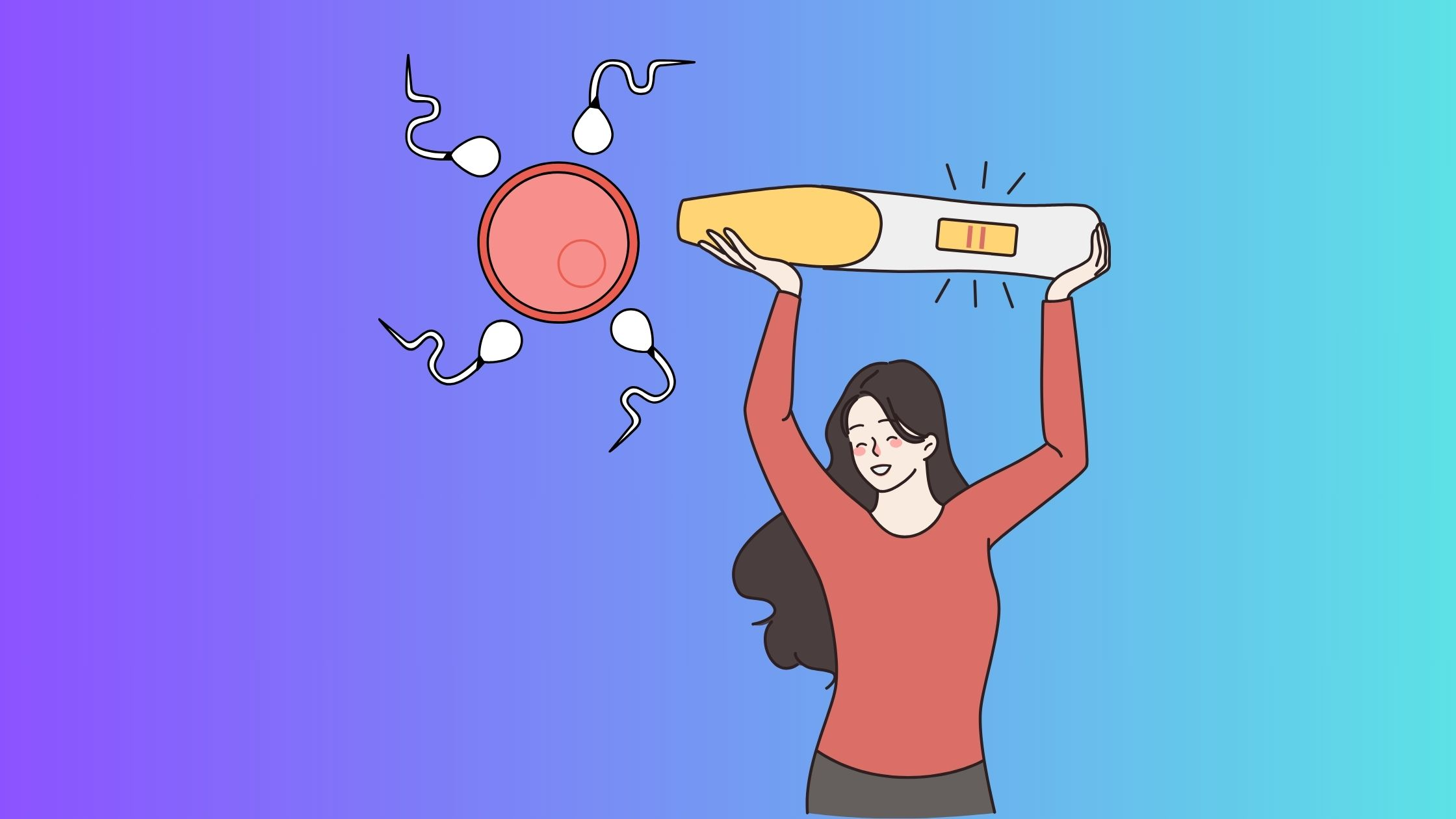If you’re trying to conceive (TTC), the anticipation of taking a pregnancy test can feel like a never-ending wait. While six days past ovulation (6 DPO) is generally too early to take a pregnancy test to be reliable, some women start to notice early pregnancy symptoms around this time.
At 6 DPO, you’re nearing the halfway mark of the two-week wait (TWW). Your logical side may tell you it’s best to wait a bit longer to take a test, but your heart might be urging you to go ahead and try. It’s a mental tug-of-war that can be both exciting and agonizing.
Although taking a pregnancy test at 6 DPO could lead to disappointment, as getting a positive result this early is rare, understanding what to expect can help ease your anxiety. Symptoms like fatigue, nausea, and cramps could be related to implantation and early pregnancy. However, remember that these symptoms are not definitive proof of pregnancy and could be due to other factors.
Let’s take a closer look at what’s happening inside your body at 6 DPO, explore the possible symptoms you could encounter, and discuss the best time to take a pregnancy test.
What Is Happening to Your Body at 6 DPO?

After ovulation, a fertilized egg travels down the fallopian tube and attaches itself to the uterine lining in a process called implantation. This usually happens between 6 to 12 days post ovulation, with most women experiencing it around 8 to 10 days post ovulation.
At 6 DPO, if you’re among the few who experience early implantation, you might start noticing some symptoms as your body prepares for pregnancy. However, it’s completely normal if you don’t feel any changes yet; everyone’s body reacts differently.
Once the egg implants, it produces the hormone human chorionic gonadotropin (hCG). This hormone is what pregnancy tests detect, and its levels double every 1-2 days in early pregnancy, peaking around 10 weeks.
So, while implantation and early symptoms can occur at this stage, most women must wait a bit longer. Tracking your cycle and understanding your body’s changes can help you navigate this exciting journey.
Knowing when you’re ovulating is crucial for timing conception. Here are some methods to help you track your cycle:
- Basal Body Temperature (BBT): Your Basal Body Temperature (BBT) is your body’s temperature when fully resting. Your BBT rises just after ovulation. By regularly tracking this temperature, you can better predict when you’re ovulating.
- Fertility Apps: These apps can help you monitor symptoms, track your cycle, and even record your BBT.
- Ovulation Predictor Kits: These kits detect elevated levels of the luteinizing hormone (LH), signaling that you’re about to ovulate.
Early Pregnancy Symptoms at 6 DPO

Even though you might be eager to notice early signs of pregnancy right after ovulation, the reality is, at six days past ovulation, there’s no telling the difference between someone pregnant and someone not.
Why? Well, these symptoms are often indistinguishable from classic premenstrual symptoms.
The hormone progesterone, responsible for many pregnancy symptoms, rises after ovulation regardless of whether you’re pregnant. Also, implantation, which triggers many pregnancy symptoms, usually doesn’t occur until around 8 to 10 DPO.
The only definitive way to confirm pregnancy is by taking a test at the appropriate time, typically after missed menses.
While a missed period is often the first recognized sign of pregnancy, some women vouch they notice subtle changes as early as six days past ovulation, including:
1. Cramping
Feeling some cramps around 6 DPO and wondering if it’s an early sign of pregnancy. You’re not alone. Implantation cramping is a common early pregnancy symptom that some women experience, and it can feel a lot like the usual cramps you get before your period. That’s why it’s easy to mix them up.
If you’re pregnant, these cramps could be your fertilized egg settling in. During implantation, some blood vessels in the uterine lining can get disrupted, which might cause mild spotting or cramping.
But remember, implantation can happen anywhere from 6 to 12 DPO, so experiencing cramps or spotting at 6 DPO could be rare but not impossible. Stress and anxiety about possibly being pregnant can also mess with your body, causing cramps and even digestion issues.
How do you tell these early pregnancy cramps apart from regular period pain? Implantation cramps are usually milder and shorter-lived, showing up between 6 to 12 DPO, while your typical period cramps tend to start around 14 DPO and are more intense.
2. Spotting
While uncommon, some women notice some spotting around 6 days past ovulation, which could be implantation bleeding.
This occurs when the fertilized egg attaches itself to the lining of your uterus. The tricky part is figuring out if it’s implantation bleeding or just the start of your period.
Here’s a tip: Implantation bleeding is usually lighter in color (pinkish brown or brown) and doesn’t last as long as a regular period. Plus, you won’t see any clots, which you might find in period blood.
3. Nausea
Nausea is another early sign that shows up around the time of implantation.
This isn’t the typical morning sickness you’d expect, as it usually doesn’t begin until a few weeks into pregnancy. Along with nausea, the hormone surge during this time can also make you feel constipated or give you indigestion.
4. Headaches and Dizziness
Some women might start feeling headaches or dizziness as early as 6 DPO. You’ve got hormones like hCG and progesterone kicking in, prepping your body for a baby. These shifts can make your head spin. But let’s not jump the gun—these symptoms can also be part of your regular premenstrual syndrome (PMS).
5. Fatigue
Are you feeling wiped out around 6 days past ovulation? You’re not alone. This tiredness could be your body’s way of saying it’s gearing up for a baby. Hormones like progesterone and hCG are the usual suspects behind this fatigue. These hormones kick in to prepare your body for pregnancy, and they can make you feel like you’ve run a marathon without even lacing up your sneakers.
6. Breast Tenderness
When a fertilized egg implants in the uterus, your body starts pumping out more estrogen and progesterone. These hormones can make your breasts feel sore, swollen, and sensitive to touch.
7. Food Cravings and Aversions
If you’re raiding the pantry more than usual, it could be your body’s way of signaling a pregnancy, or it could just be gearing up for your next period. While the science isn’t crystal clear on why cravings kick in, it’s likely due to hormonal changes or your body’s telling you it needs certain nutrients.
Here’s another twist: You might find yourself turned off by foods you usually can’t get enough of and suddenly loving foods you’d never touch otherwise.
While indulging in cravings isn’t the end of the world, try to balance it. Stick to your usual healthy diet as much as possible, especially if you hope to make your body a welcoming home for a new life.
8. Mood Swings
Feeling extra emotional lately? You might be dealing with early pregnancy mood swings. Hormones like progesterone and hCG are usually to blame. These mood shifts can also be more intense if you’re pregnant, so watch what sets you off. It could help your doctor figure out if you’re expecting. And remember, it’s not just mood swings; some women also experience anxiety or depression.
Can You Implant at 6 DPO?
The idea that you can feel implantation is actually a myth. Most women can’t physically sense when implantation occurs.
Usually, early pregnancy signs like nausea and fatigue are due to hormones like progesterone and hCG, not implantation. These symptoms often kick in about 1 to 2 weeks after you miss your period, although some women might feel them as early as 9 to 10 DPO.
And let’s be clear: according to a study, the odds of implantation happening at 6 DPO are as low as 0.5 percent. Most women experience implantation around 8 to 10 days after ovulation. So, if you’re feeling something at this stage, it’s probably not implantation.
Accuracy of Pregnancy Test at 6 DPO

Many women take a pregnancy test 6 days past ovulation to determine if they’re pregnant. However, not all tests are reliable this early on.
Taking a test too early might give you a false result. Most over-the-counter tests can’t pick up hCG levels below 20 mIU/mL. Therefore, the ideal time to take a pregnancy test is around 10 days after ovulation. By this time, the hormone hCG levels are sufficient for most tests to detect pregnancy accurately.
Also, remember that hCG levels double roughly every 36 to 48 hours, peaking around 9 to 10 weeks into the pregnancy. So, while it’s not impossible to get a positive result at 6 DPO, it’s unlikely.
If you receive a positive result at 6 DPO, it indicates you may be pregnant. However, hCG levels still need to be higher at this stage, so the test’s accuracy isn’t guaranteed.
Should your home test yield a positive result, consult your doctor promptly for confirmation. Doctors can perform a blood test between 7-10 DPO and an ultrasound between 11-14 DPO to verify your pregnancy.
Is 6 DPO Too Early to Test for Pregnancy?
Testing for pregnancy six days past ovulation is generally too early for accurate results. Even if you’re among the rare cases where implantation occurs at 6 DPO, the hormone hCG—which pregnancy tests detect—likely hasn’t reached a detectable level in your urine. So, a negative test result at this stage doesn’t necessarily mean you’re not pregnant; it could be a false negative.
Waiting until at least 10 to 12 DPO to take a home pregnancy test is best for more reliable results. By then, hCG levels are high enough for most tests to detect if you’re pregnant. If you’re eager to know sooner, consider scheduling a blood test with your doctor around 7-10 days past ovulation, as these tests can be more sensitive.
6 DPO and Positive Pregnancy Test (BFP)
Getting a positive pregnancy test at 6 DPO is uncommon but not impossible. If you do get a positive result this early, it’s essential to retest about a week later or after your missed period for more accurate results. Home pregnancy tests measure the hormone hCG, which usually takes time to reach detectable levels in your urine.
If you’re eager for early results, a blood test can detect hCG levels more sensitively and can be done as early as 6 DPO. However, these blood tests are generally reserved for high-risk patients or those undergoing fertility treatments.
6 DPO and Negative Pregnancy Test (BFN)
If you’ve taken a pregnancy test 6 days past ovulation (DPO) and it’s negative, don’t lose hope. It’s common to get a negative result at this stage, even if you are pregnant.
That’s because implantation may not have occurred yet, and even if it has, the hormone hCG takes time to reach detectable levels in your urine.
The best course of action is to wait until 10 DPO to test again for a more accurate result.
What If You Don’t Experience Any Pregnancy Symptoms at 6 DPO?
There’s no need to worry if you’re 6 days past ovulation and have yet to experience pregnancy symptoms. Many women don’t start experiencing symptoms until well into their pregnancy, sometimes as late as 8 weeks after their last menstrual cycle.
Moreover, symptoms at this early stage can easily be mistaken for premenstrual symptoms, as they can feel quite similar. Try not to stress; the absence of symptoms at this stage is normal.
What Does It Mean If You Have Nausea At 6 DPO?
If you’re experiencing nausea 6 days past ovulation, it’s natural to wonder if it could be an early sign of pregnancy. However, it’s generally too soon for nausea to be a reliable indicator.
Most women don’t start feeling nauseous until a week or two after their missed period. Known as “morning sickness,” this symptom can actually last all day and usually begins before the ninth week of pregnancy, tapering off by the end of the first trimester.
And it’s not only the pregnancy hormone that causes nausea; it could be due to various other factors, such as eating something, a stomach bug, or even premenstrual symptoms.
Why Are You Cramping 6 Days After Ovulation?
Cramping 6 DPO doesn’t necessarily indicate pregnancy. It could be related to elevated hormone progesterone levels, which occur at 6 DPO whether you’re pregnant or not.
Cramping can also result from stress, digestion, or simply your body preparing for menstruation. You might consider taking a home pregnancy test if you’re also experiencing symptoms like fatigue or breast tenderness.
Does Cervical Mucus Change After Conception Around 6 DPO?
After ovulation, vaginal discharge usually decreases, but if you’re pregnant, it might stay the same or even increase. You could also notice a change in color, like a pink or brownish tint. However, these signs aren’t definitive proof of pregnancy.
Factors like stress or illness can also affect your cervical mucus. You can track these changes and other symptoms like cramps or fatigue if you’re eager to know.
Takeaway
Early Testing & Symptoms: Taking a pregnancy test at 6 DPO is generally too early for accurate results. Some women may experience symptoms like fatigue, nausea, and cramps, but these are not definitive indicators of pregnancy.
Body Changes: After ovulation, a fertilized egg may travel down the fallopian tube and attach to the uterine lining during implantation. However, this usually occurs between 8 to 10 DPO, making early implantation at 6 DPO rare.
Hormonal Influence: Hormones like human chorionic gonadotropin (hCG) and progesterone increase after implantation. These hormones are responsible for many pregnancy symptoms but are also present in premenstrual syndrome (PMS).
Methods to Track Ovulation: Knowing when you’re ovulating is crucial for timing conception. Methods include tracking Basal Body Temperature (BBT) using fertility apps and Ovulation Predictor Kits.
Consult a Doctor for Confirmation: If you experience early signs of pregnancy or get a positive test result at 6 DPO, it’s advisable to consult a doctor for more accurate testing and confirmation.
References
Gnoth, C, and S Johnson. "Strips of Hope: Accuracy of Home Pregnancy Tests and New Developments." Geburtshilfe Und Frauenheilkunde, July 2014, www.ncbi.nlm.nih.gov/pmc/articles/PMC4119102/.Chard, T. "Pregnancy Tests: a Review." Human Reproduction (Oxford, England), U.S. National Library of Medicine, May 1992, www.ncbi.nlm.nih.gov/pubmed/1639991.Orloff, Natalia C, and Julia M Hormes. "Pickles and Ice Cream! Food Cravings in Pregnancy: Hypotheses, Preliminary Evidence, and Directions for Future Research." Frontiers in Psychology, Sept 23 2014, www.ncbi.nlm.nih.gov/pmc/articles/PMC4172095/.P.A. Nepomnaschy, C.R. Weinberg, A.J. Wilcox, D.D. Baird, Urinary hCG patterns during the week following implantation, Human Reproduction, Volume 23, Issue 2, February 2008, Pages 271–277, https://doi.org/10.1093/humrep/dem397Allen J. Wilcox, Donna Day Baird, Clarice R. Weinberg, Time of Implantation of the Conceptus and Loss of Pregnancy, The New England Journal of Medicine, Jun 10, 1999
